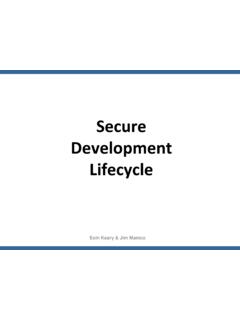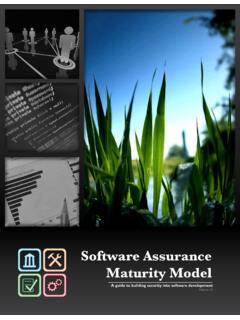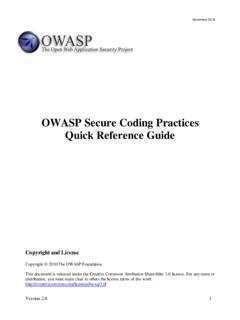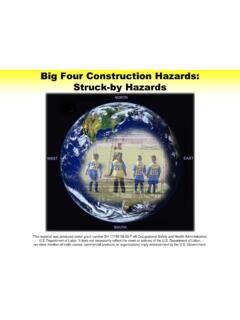Transcription of OWASP Top 10 - 2013
1 O About OWASP Copyright and License Copyright 2003 2013 The OWASP Foundation This document is released under the Creative Commons Attribution ShareAlike license. For any reuse or distribution, you must make it clear to others the license terms of this work. Foreword Insecure software is undermining our financial, healthcare, defense, energy, and other critical infrastructure. As our digital infrastructure gets increasingly complex and interconnected, the difficulty of achieving application security increases exponentially. We can no longer afford to tolerate relatively simple security problems like those presented in this OWASP Top 10. The goal of the Top 10 project is to raise awareness about application security by identifying some of the most critical risks facing organizations.
2 The Top 10 project is referenced by many standards, books, tools, and organizations, including MITRE, PCI DSS, DISA, FTC, and many more. This release of the OWASP Top 10 marks this project s tenth anniversary of raising awareness of the importance of application security risks. The OWASP Top 10 was first released in 2003, with minor updates in 2004 and 2007. The 2010 version was revamped to prioritize by risk, not just prevalence. This 2013 edition follows the same approach. We encourage you to use the Top 10 to get your organization started with application security. Developers can learn from the mistakes of other organizations. Executives should start thinking about how to manage the risk that software applications create in their enterprise.
3 In the long term, we encourage you to create an application security program that is compatible with your culture and technology. These programs come in all shapes and sizes, and you should avoid attempting to do everything prescribed by some process model. Instead, leverage your organization s existing strengths to do and measure what works for you. We hope that the OWASP Top 10 is useful to your application security efforts. Please don t hesitate to contact OWASP with your questions, comments, and ideas, either publicly to or privately to About OWASP The Open Web Application Security Project ( OWASP ) is an open community dedicated to enabling organizations to develop, purchase, and maintain applications that can be trusted. At OWASP you ll find free and open.
4 Application security tools and standards Complete books on application security testing, secure code development, and secure code review Standard security controls and libraries Local chapters worldwide Cutting edge research Extensive conferences worldwide Mailing lists Learn more at: All of the OWASP tools, documents, forums, and chapters are free and open to anyone interested in improving application security. We advocate approaching application security as a people, process, and technology problem, because the most effective approaches to application security require improvements in all of these areas. OWASP is a new kind of organization. Our freedom from commercial pressures allows us to provide unbiased, practical, cost-effective information about application security.
5 OWASP is not affiliated with any technology company, although we support the informed use of commercial security technology. Similar to many open source software projects, OWASP produces many types of materials in a collaborative, open way. The OWASP Foundation is the non-profit entity that ensures the project s long-term success. Almost everyone associated with OWASP is a volunteer, including the OWASP Board, Global Committees, Chapter Leaders, Project Leaders, and project members. We support innovative security research with grants and infrastructure. Come join us! Welcome Welcome to the OWASP Top 10 2013 ! This update broadens one of the categories from the 2010 version to be more inclusive of common, important vulnerabilities, and reorders some of the others based on changing prevalence data.
6 It also brings component security into the spotlight by creating a specific category for this risk, pulling it out of the obscurity of the fine print of the 2010 risk A6: Security Misconfiguration. The OWASP Top 10 for 2013 is based on 8 datasets from 7 firms that specialize in application security, including 4 consulting companies and 3 tool/SaaS vendors (1 static, 1 dynamic, and 1 with both). This data spans over 500,000 vulnerabilities across hundreds of organizations and thousands of applications. The Top 10 items are selected and prioritized according to this prevalence data, in combination with consensus estimates of exploitability, detectability, and impact estimates. The primary aim of the OWASP Top 10 is to educate developers, designers, architects, managers, and organizations about the consequences of the most important web application security weaknesses.
7 The Top 10 provides basic techniques to protect against these high risk problem areas and also provides guidance on where to go from here. Warnings Don t stop at 10. There are hundreds of issues that could affect the overall security of a web application as discussed in the OWASP Developer s Guide and the OWASP Cheat Sheet Series. These are essential reading for anyone developing web applications. Guidance on how to effectively find vulnerabilities in web applications is provided in the OWASP Testing Guide and the OWASP Code Review Guide. Constant change. This Top 10 will continue to change. Even without changing a single line of your application s code, you may become vulnerable as new flaws are discovered and attack methods are refined.
8 Please review the advice at the end of the Top 10 in What s Next For Developers, Verifiers, and Organizations for more information. Think positive. When you re ready to stop chasing vulnerabilities and focus on establishing strong application security controls, OWASP has produced the Application Security Verification Standard (ASVS) as a guide to organizations and application reviewers on what to verify. Use tools wisely. Security vulnerabilities can be quite complex and buried in mountains of code. In many cases, the most cost-effective approach for finding and eliminating these weaknesses is human experts armed with good tools. Push left. Focus on making security an integral part of your culture throughout your development organization.
9 Find out more in the Open Software Assurance Maturity Model (SAMM) and the Rugged Handbook. Attribution Thanks to Aspect Security for initiating, leading, and updating the OWASP Top 10 since its inception in 2003, and to its primary authors: Jeff Williams and Dave Wichers. We d like to thank those organizations that contributed their vulnerability prevalence data to support the 2013 update: Aspect Security Statistics HP Statistics from both Fortify and WebInspect Minded Security Statistics Softtek Statistics Trustwave, SpiderLabs Statistics (See page 50) Veracode Statistics WhiteHat Security Inc. Statistics We would like to thank everyone who contributed to previous versions of the Top 10. Without these contributions, it wouldn t be what it is today.
10 We d also like to thank those who contributed significant constructive comments and time reviewing this update to the Top 10: Adam Baso (Wikimedia Foundation) Mike Boberski (Booz Allen Hamilton) Torsten Gigler Neil Smithline (MorphoTrust USA) For producing the wiki version of the Top 10, and also providing feedback And finally, we d like to thank in advance all the translators out there that will translate this release of the Top 10 into numerous different languages, helping to make the OWASP Top 10 more accessible to the entire planet. I Introduction What Changed From 2010 to 2013 ? The threat landscape for applications security constantly changes. Key factors in this evolution are advances made by attackers, the release of new technologies with new weaknesses as well as more built in defenses, and the deployment of increasingly complex systems.












